| Volume 2011/12, Issue 7 | January 3, 2012 |
|

Cal-Neva AFS Meeting:
March 28-31
Salmonid Restoration Federation Conference:
April 4-7
|
|
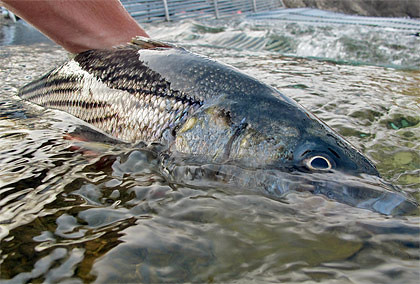
|
Key Highlights
December 5 - December 25, 2011
Stanislaus River Weir Monitoring continued during the reporting period. A total of 109 Chinook salmon passed upstream through the weir between December 5 and December 25, increasing the total count since November 8th to 793.
Tuolumne River Weir Monitoring continued during the reporting period. A total of 155 Chinook salmon passed upstream through the weir between December 5 and December 25, increasing the season total to 2,801.
Mokelumne River Woodbridge Dam Fish Ladder Monitoring continued during the reporting period and a total of 207 Chinook passed upstream of the dam between December 5 and December 25, increasing the season total to 18,555.
Calaveras River Juvenile Migration Monitoring continued at Shelton Road (RM 28) during the reporting period.A total of 5 O. mykiss were captured increasing the season total to 26.
Stanislaus River Juvenile Migration Monitoring continued at Oakdale (RM 40) during the reporting period. A total of 16 Chinook salmon were captured increasing the season total to 21.
Mokelumne River Juvenile Migration Monitoring at Vino Farms (RM 54) began on December 12 and a total of 19 Chinook salmon were captured during the reporting period.
San Joaquin River Conditions. San Joaquin River flow at Vernalis ranged from 1,448 cfs to 1,820 cfs. Water temperature in the San Joaquin River decreased from 48.2°F to 44.7°F at Vernalis, and from 48.8°F to 45.1°F at Mossdale. Average daily dissolved oxygen (DO) in the San Joaquin River ranged from 10.9 mg/L to 11.9 mg/L at Mossdale, and from 9.8 mg/L to 10.6 mg/L at Rough 'n Ready.
Delta Exports. Combined total exports (state and federal pumps) fluctuated during the reporting period, decreased from 10,719 cfs to 6,604 cfs.
|
|
2011 Stanislaus River Weir Adult Migration Monitoring
Between December 5 and December 25 the Vaki Riverwatcher detected a total of 109 fall-run Chinook salmon as they passed upstream of the Stanislaus River weir, 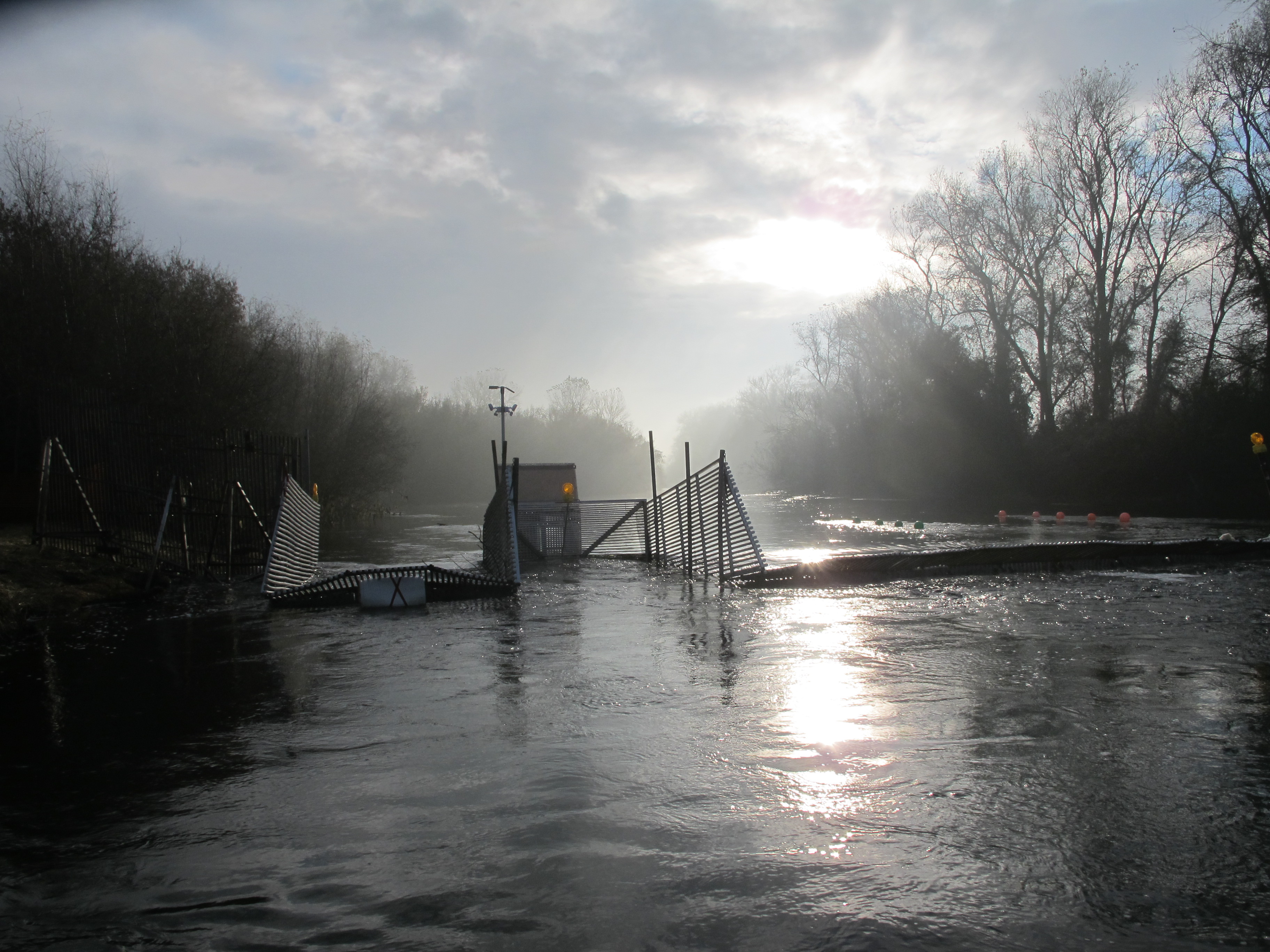 increasing cumulative passage since November 8th to 693 salmon (Figure 1; Table 1). Daily passage during the sampling period ranged from 0 to 12 Chinook salmon (Figure 2). increasing cumulative passage since November 8th to 693 salmon (Figure 1; Table 1). Daily passage during the sampling period ranged from 0 to 12 Chinook salmon (Figure 2).
Instantaneous water temperature measured at the weir ranged from 44.2˚F to 47.6˚F, and daily average water temperature at Ripon (RPN; RM 15) decreased from 48.8˚F to 45.3˚F (Figure 3). Instantaneous turbidity ranged between 0.62 NTU and 1.57 NTU (Figure 4). Instantaneous dissolved oxygen at the weir ranged between 9.32 mg/L and 12.68 mg/L, and daily average dissolved oxygen at Ripon ranged from 10.47 mg/L to 11.27 mg/L (Figure 5).
Daily average flows in the Stanislaus River at Goodwin Dam (GDW; RM 58) ranged from 503 cfs to 517 cfs. Flows at Ripon ranged from 530 cfs to 586 cfs. Note: flows downstream of Goodwin Dam may differ from dam releases due to irrigation, precipitation and other factors.
Table 1. Annual fall-run Chinook passage at the Stanislaus River weir prior to December 25, 2003-2011. Due to high flows throughout September and October, the Stanislaus River weir began sampling later than usual in 2011. Thus, the second column of Table 1 limits the inter-annual comparison to passage between November 8 and December 25.
Figure 1. Cumulative passage of fall-run Chinook salmon recorded at the Stanislaus River weir from 2003-2011. Note: Monitoring did not begin in 2011 until November 8. Figure 2. Daily upstream Chinook passage at the Stanislaus River weir in relation to daily average flows (cfs) recorded in the Stanislaus River at Goodwin (GDW) and Ripon (RIP), 2011. Figure 3. Daily upstream Chinook passage recorded at the Stanislaus River weir in relation to instantaneous water temperature recorded at the weir, and daily average water temperature recorded in the Stanislaus River at Ripon (RPN), and in the San Joaquin River at Vernalis (VER), Mossdale (MSD) and Rough & Ready (RRI) in 2011. Figure 4. Daily upstream Chinook passage at the Stanislaus River weir in relation to instantaneous turbidity recorded at the weir in 2011. Figure 5. Daily upstream Chinook passage at the Stanislaus River weir in relation to instantaneous dissolved oxygen recorded at the weir, and daily average dissolved oxygen recorded in the Stanislaus River at Ripon (RPN), and in the San Joaquin River at Mossdale (MSD) and Rough & Ready (RRI) in 2011.
|
2011 Tuolumne River Weir Adult Migration Monitoring
Between December 5 and December 25 a total of 155 Chinook salmon were detected by the Vaki Riverwatcher as they passed upstream of the Tuolumne River weir, increasing the season total to 2,801 (Figure 6; Table 2). Daily passage ranged between 0 and 22 Chinook salmon (Figure 7).
Daily average flow in the Tuolumne River ranged from 359 cfs to 367 cfs at La Grange (LGN; RM 50) and from 445 cfs to 466 cfs at Modesto (MOD; RM 17; Figure 4). Note: flows downstream of La Grange may be higher than dam releases due to accretion and Dry Creek inflow.
Instantaneous water temperature measured at the weir ranged from 47.6˚F and 50.0˚F and daily average water temperature at Modesto ranged from 46.8˚F and 49.3˚F (Figure 8). Instantaneous turbidity ranged between 0.43 NTU and 1.62 NTU (Figure 9), and instantaneous dissolved oxygen ranged between 9.87 mg/L and 12.78 mg/L (Figure 10).
Table 2. Annual fall-run Chinook passage at the Tuolumne River weir prior to December 25, 2009 - 2011.
Figure 6. Fall-Run Chinook salmon cumulative passage recorded at the Tuolumne River weir in 2009 - 2011.
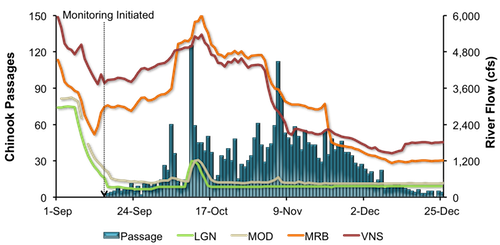
Figure 7. Daily upstream Chinook passage at the Tuolumne River Weir in relation to daily average flows (cfs) recorded in the Tuolumne River at La Grange (LGN) and Modesto (MOD), and in the San Joaquin River at Maze Road Bridge (MRB) and Vernalis (VNS) in 2011.
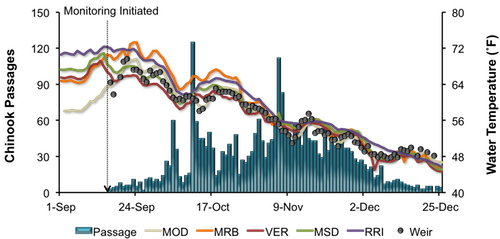
Figure 8. Daily upstream Chinook passage at the Tuolumne River Weir in relation to instantaneous water temperature recorded at the weir, and daily average water temperature recorded in the Tuolumne River at Modesto (MOD) and in the San Joaquin River at Maze Road Bridge (MRB), Vernalis (VER), Mossdale (MSD) and Rough & Ready (RRI) in 2011.
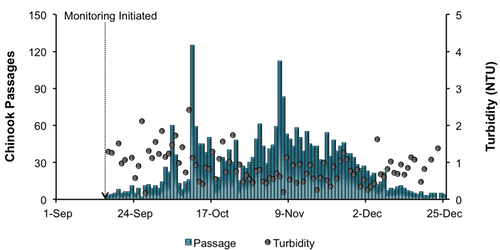
Figure 9. Daily upstream Chinook passage at the Tuolumne River Weir in relation to instantaneous turbidity recorded at the weir in 2011.
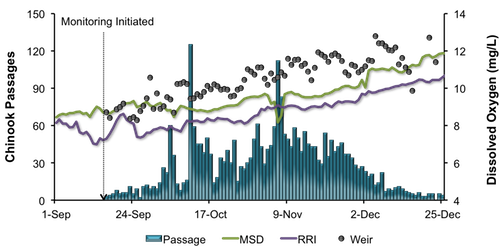
Figure 10. Daily upstream Chinook passage at the Tuolumne River Weir in relation to instantaneous dissolved oxygen recorded at the weir, and daily average dissolved oxygen recorded in the San Joaquin River at Mossdale (MSD) and Rough & Ready (RRI) in 2011.
|
Mokelumne River Woodbridge Dam Fish Ladder Monitoring Fall-run Chinook salmon returning to the Mokelumne River are counted annually by East Bay Municipal Utility District (EBMUD) as they ascend the fish ladder at Woodbridge Dam. During the reporting period 207 Chinook salmon were observed passing upstream of the dam, increasing the season total to 18,555 (Figure 11). Daily passage ranged between 1 and 20 Chinook salmon. Daily average flow in the Mokelumne River ranged from 331 cfs to 335 cfs at Camanche Reservoir (CMN) during the reporting period.

Figure 11. Daily upstream Chinook passage recorded at the Woodbridge Dam fish ladder in relation to daily average flows (cfs) recorded in the Mokelumne River at Camanche Reservoir (CMN), 2011.
|
San Joaquin Basin Escapement Surveys Annual carcass surveys conducted by CDFG continued through the week of December 19. Few live fish were counted, and spawning activity has been on the decline since the week of November 28.
A total of 15 redds were observed on the Merced River, 2 on the Tuolumne River, and 64 were recorded on the Stanislaus River during the week of December 19.
A total of 73 female Chinook salmon have been spawned at the Merced River Fish Facility (MRFF) as of December 25.
|
2011/12 Calaveras River Juvenile Migration Monitoring
The Calaveras River rotary screw trap at Shelton Road (RM 28) sampled for 16 days between December 5 and December 25. A total of 5 O. mykiss were captured  during the reporting period, increasing the season total to 26. Daily catches ranged from 0 to 2 individuals (Figure 12), and all O. mykiss captured were Age 1+ (100-299 mm) and were rated as silvery parr (n=4). Average forklengths and weights of O. mykiss are provided in Table 3. during the reporting period, increasing the season total to 26. Daily catches ranged from 0 to 2 individuals (Figure 12), and all O. mykiss captured were Age 1+ (100-299 mm) and were rated as silvery parr (n=4). Average forklengths and weights of O. mykiss are provided in Table 3.
No Chinook salmon were captured during this reporting period.
Instantaneous temperature recorded at the trap ranged from 43.7ºF to 47.6ºF, and turbidity ranged from 0.50 NTU to 1.66 NTU. During the reporting period, daily average combined flow from New Hogan Dam (NHG) and Cosgrove Creek (COS) ranged from 94 cfs up to 106 cfs, and at Bellota (MRS) flow fluctuated between 37 cfs and 102 cfs.
Table 3. Biosampling data for O. mykiss captured at Shelton Road between December 5 and December 25, 2011. Parenthesis indicates range.

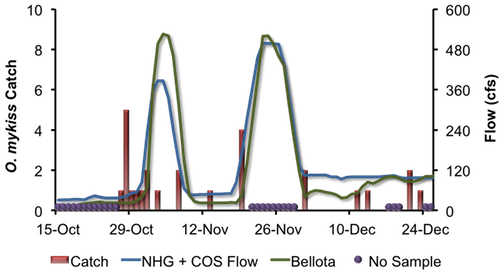
Figure 12. Daily O. mykiss catch at Shelton Road, and Calaveras River flow recorded by New Hogan Dam (NHG) and Cosgrove Creek (COS) combined and flow recorded at Bellota (MRS), in 2011.
|
2011/12 Stanislaus River Juvenile Migration Monitoring
The Stanislaus River rotary screw trap at Oakdale (RM 40) operated continuously 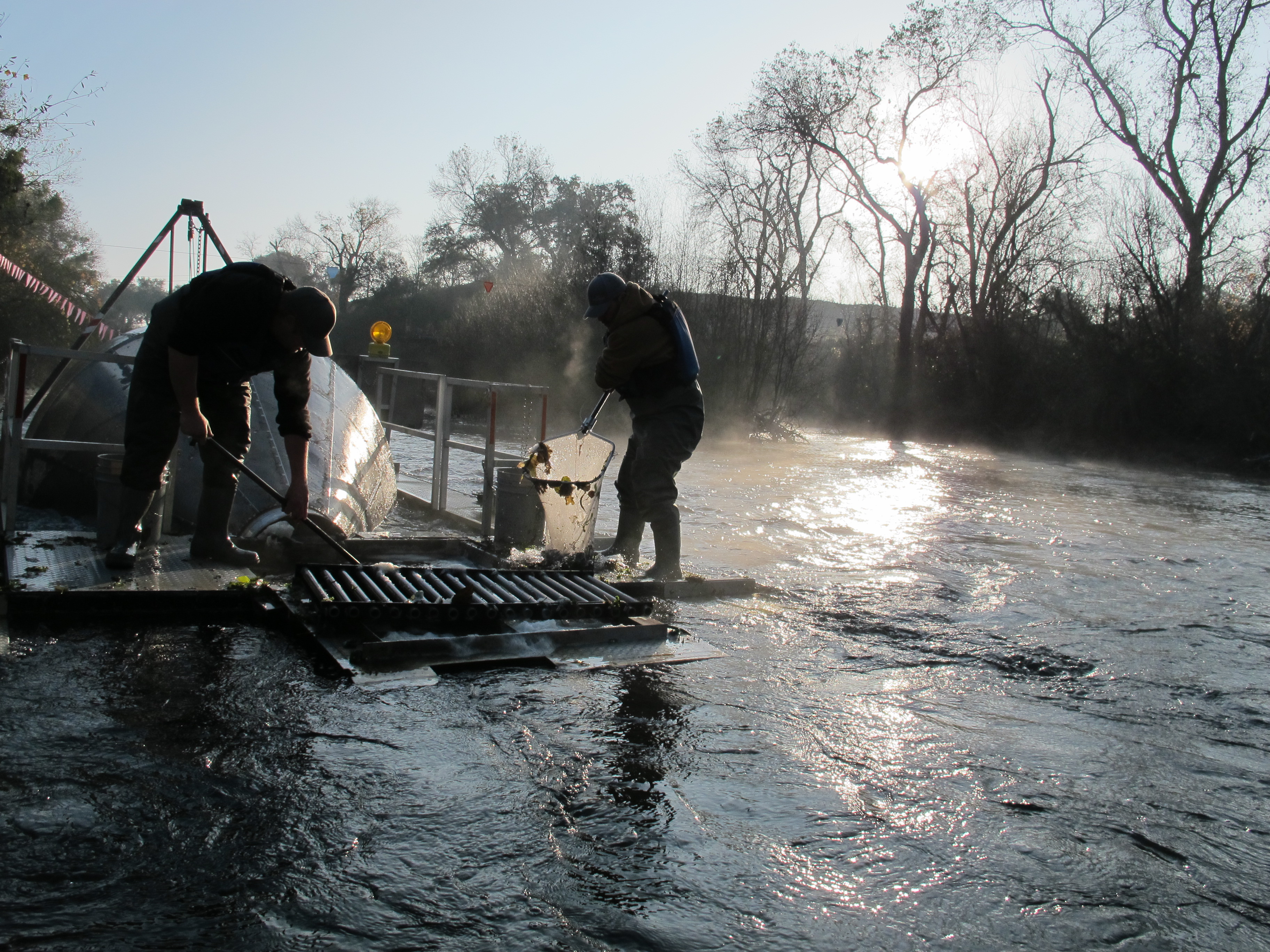 between December 5 and December 25. A total of 16 Chinook salmon were captured during the reporting period, increasing the season total to 21. Two of the Chinook salmon captured were greater than 100 mm and were rated as smolts. A variety of other fish species were captured, including Sacramento sucker (n=5), Sacramento pikeminnow (n=4), and Tule perch (n=3) (Table 4). between December 5 and December 25. A total of 16 Chinook salmon were captured during the reporting period, increasing the season total to 21. Two of the Chinook salmon captured were greater than 100 mm and were rated as smolts. A variety of other fish species were captured, including Sacramento sucker (n=5), Sacramento pikeminnow (n=4), and Tule perch (n=3) (Table 4).
Four O. mykiss were captured during the reporting period increasing the season total to 14.
Instantaneous temperature taken at the trap ranged from 44.6ºF to 47.1ºF, and turbidity ranged from 0.22 NTU to 1.97 NTU. Daily average flow at Goodwin Dam (GDW) ranged from 503 cfs to 517 cfs, and from 530 cfs to 580 cfs flows at Ripon (RIP) (Figure 13).
Table 4. Biosampling data for all species captured and measured at Oakdale between December 5 and December 25, 2011.
  Figure 13. Daily Chinook salmon catch at Oakdale and Stanislaus River flow recorded at Goodwin Dam (GDW) and Ripon (RIP) in 2011.
|
2011/12 Mokelumne River Juvenile Migration Monitoring
The Mokelumne River rotary screw trap at Vino Farms (RM 54) was installed and intermittent monitoring began on December 12, 2011 and a total of 19 juvenile Chinook salmon have been captured through the end of the reporting period.
Average daily flow from Camanche Reservoir (CMN) ranged from 330 cfs to 342 cfs (Figure 14). Instantaneous temperature ranged between 48.9°F and 52.3°F, and instantaneous turbidity ranged between 1.73 NTU and 3.72 NTU.
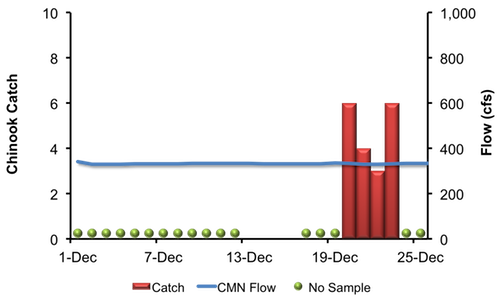 Figure 14. Daily Chinook salmon catch at Vino Farms and Mokelumne River flow releases from Camanche Reservoir (CMN) in 2011.
|
San Joaquin River Conditions
During the reporting period, flow in the San Joaquin River at Vernalis ranged from 1,448 cfs to 1,820 cfs (Figure 15). Water temperature in the San Joaquin River decreased from 48.2°F to 44.7°F at Vernalis, from 48.8°F to 45.1°F at Mossdale, and from 50.7°F to 45.8°F at Rough 'n Ready Island (Figure 16). Average daily dissolved oxygen (DO) in the San Joaquin River fluctuated from 10.9 mg/L to 11.9 mg/L at Mossdale, and from 9.8 mg/L to 10.6 mg/L in the deep-water ship channel (measured at Rough 'n Ready Island; Figure 17).
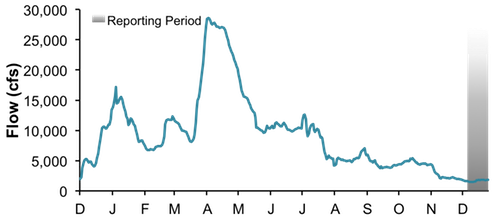
Figure 15. San Joaquin River flow at Vernalis from December 1, 2010, through December 25, 2011.
Figure 16. San Joaquin River daily average water temperature at Vernalis, Mossdale, and Rough 'n Ready from December 1, 2010, through December 25, 2011.
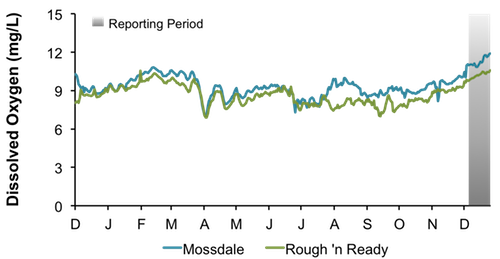
Figure 17. San Joaquin River daily average dissolved oxygen at Mossdale and Rough 'n Ready, from December 1, 2010, through December 25, 2011.
|
|
Delta Exports
Mean daily pumping at the C.W. Jones Pumping Plant (federal pumps previously known as Tracy Pumping Plant) ranged from 3,924 cfs to 4,031 cfs (Figure 18). Mean daily pumping at the Harvey O. Banks Pumping Plant (state pumps) decreased from 6,604 cfs to 2,606 cfs. Combined total exports (state and federal pumps) during this period decreased from 10,719 cfs to 6,604 cfs.
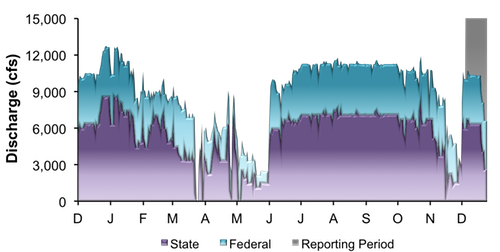
Figure 18. Daily exports at the state and federal pumping stations from December 1, 2010, through December 25, 2011.
|
|
|
|
|
|
|